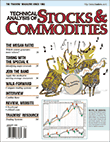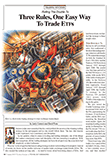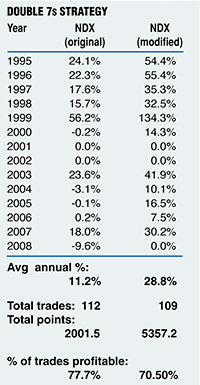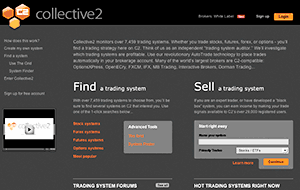March 2009 Letters To The Editor
The editors of S&C invite readers to submit their opinions and information on subjects relating to technical analysis and this magazine. This column is our means of communication with our readers. Is there something you would like to know more (or less) about? Tell us about it. Without a source of new ideas and subjects coming from our readers, this magazine would not exist.
Address your correspondence to: Editor, Stocks & Commodities, 4757 California Ave. SW, Seattle, WA 98116-4499, or E-mail to editor@traders.com. All letters become the property of Technical Analysis, Inc. Letter-writers must include their full name and address for verification. Letters may be edited for length or clarity. The opinions expressed in this column do not necessarily represent those of the magazine. —Editor
Good Issue
 Editor,
Editor,
I enjoyed the January 2009 issue of Stocks & Commodities. Larry Connors and David Penn’s article, “Three Rules, One Easy Way To Trade Etfs,” was informative. Cynthia Kase [interviewed for that issue] said it best: “Just learn a market and trade it up and down, up and down on the pure technicals. That’s the thing to do!”
Your magazine is a must-read for all traders.
—CJ Casebeer,
Nampa, ID
Thank you for your feedback. We are glad you are enjoying the magazine.
—Editor
System Backtesting Results
Editor,
I would suggest that you strongly encourage that any and every contributed article about trading systems include a backtest with clearly stated entry, exit, stop-losses, profit-taking rules, and performance figures (equity/drawdown curves, % winners, Tim, k ratio, and so on). Ideally, the systems would be tested on a standard diversified portfolio established/suggested by Stocks & Commodities, which could include stock indexes, currencies, as well as agricultural and financial commodities. At the very least, systems should be tested on major indexes in main asset classes (for example, Dia, Spy, Qqqq, Crb, Dxy, and so on). I think that this type of information would attract a lot of interest from current and potential readers. At least one of Stocks & Commodities’ competitors does this very well.
Many thanks.
—LJ
Thank you for this valuable feedback. We will certainly consider implementing this in the future.
—Editor
Rolling The Double 7s
Editor,
First, let me take this opportunity to thank you for a great publication.
I have a question regarding an article in the January 2009 issue of your magazine. I just finished reading “Rolling The Double 7s: Three Rules, One Easy Way To Trade Etfs.” I’m impressed with the backtesting results and with the simplicity of the system, but the authors did not cover how they exit or manage losing trades. Can they expand on their system for limiting losses? Thanks again.
—Luis Ordaz
Larry Connors replies:
Thank you. We’re glad you enjoyed the Double 7s strategy.
Most reversion-to-the-mean strategies will show lower test results (and often lower real trading results) when using stops. I published this finding in my newest book, Short Term Trading Strategies That Work. For a number of traders, stops are important but they are an expensive form of insurance. We feel there are better ways to protect a position and a portfolio, such as position size, hedging, and so on.
Double 7s
 Editor,
Editor,
I thank your magazine and authors Larry Connors and David Penn for an excellent strategy described in the article “Three Rules, One Easy Way To Trade Etfs” in the January 2009 Stocks & Commodities.
One small point to avoid confusion: In Figure 2, point C is only a seven-day high if they are defining the seven-day high as including the day of the trading. The original Donchian channels were based on the prior seven days, not including the present day.
Now to the meat of my letter. I coded Larry Connors’ Double 7s strategy described in the article in Matlab. I backtested $Ndx from January 1995 to April 30, 2008, and I checked several other Etfs, as Connors and Penn did. They didn’t report their average annual return. For Ndx, my result was a gain of 2001.5 points (not 2,822), 11.1% annual average return (using 252 trading days per year), and 77.7% of the trades (112 trades total) were profitable. I also had good results on Gld, Fxi, and Ewz, where the percentage of trades profitable was 65—75%. I commend them for an excellent system.
I started wondering whether performance could be improved by catching the big moves up, when the price keeps rising after hitting the seven-day high. Therefore, I modified the Double 7s (per Alex Elder’s buying methods in his triple screen strategy) as follows:
- Set a buy-stop 0.1 above the close of the seven-day low, and keep moving the buy-stop down above each day’s close until you are bought in. This often gets you in at lower prices when the price keeps going down after hitting the seven-day low.
- Set a sell-stop 0.1 below the close of the seven-day high, and keep moving it below the close each day until you are sold out.
- One important exception on point 2 above: After the seven-day high (day 1), if the next three days’ highs finish above day 1’s close, loosen the sell-stop to just under the seven-day low channel. The optimum sell-stop was 5% of the seven-day channel width below the seven-day low, but as long as you keep it under the channel low, it will work. This allows you to catch the long runups.
My results for the modified Double 7s on Ndx system is as follows: total 5,357.2 points, 28.8% average annual return, 70.5% of trades were profitable. Of the 112 total trades, 55 were runups, where the sell occurred more than three days after the seven-day high was hit. For example, this method caught the 48% runup from 10/19/99 to 1/5/2000, where the price ran along the seven-day high for months. It seems that this modification is well worth doing and is not much more complicated.
Here is my summary table for each year’s performance (see Figure 1). The performance for 2008 goes up through 4/30/2008.

FIGURE 1. Sample system results for Double 7s and modified Double 7s strategy
Thanks for your excellent articles.
—Kirk Dolan
Dax Futures Scalper
Editor,
I am a scalper/trader using the Ensign Software platform. Do you know of any indicators or trading systems for trading Dax futures? It would help me to know about any websites, books, or forums for scalpers or intraday traders.
—Name withheld, Italy
There are a number of trading systems available for trading Dax futures. A Google search will provide an extensive list. I would recommend that you visit sites such as collective2.com to help find systems that trade the Dax futures.
—Editor
